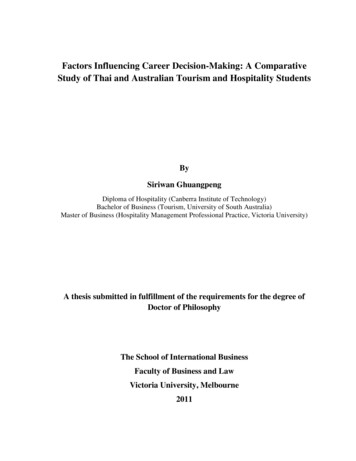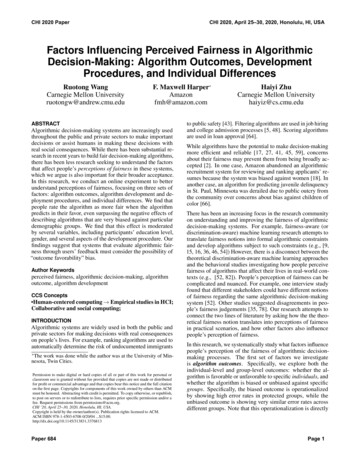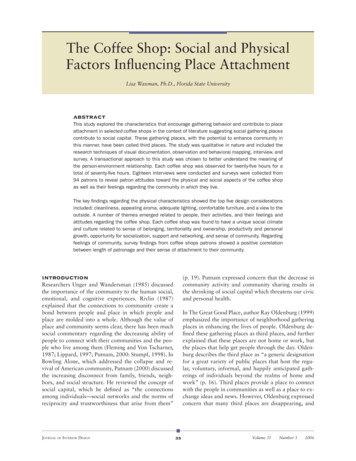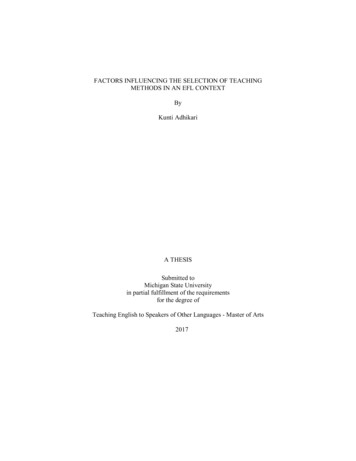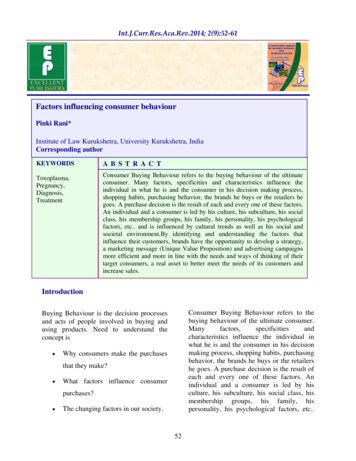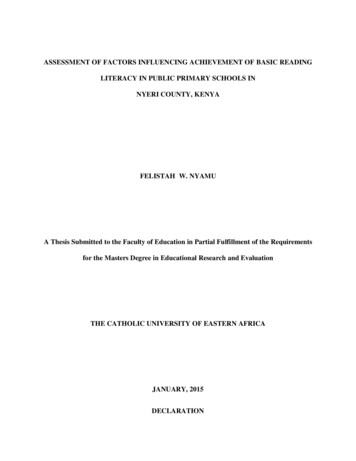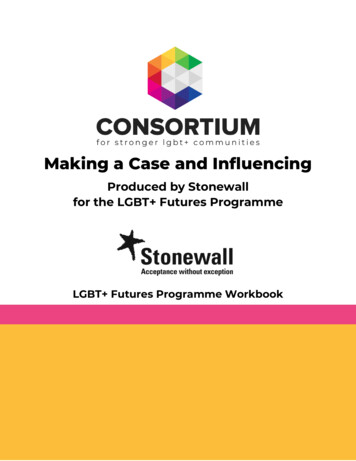
Transcription
Making a Case and InfluencingProduced by Stonewallfor the LGBT Futures ProgrammeLGBT Futures Programme Workbook
LGBT Futures Skills Development and Training Programme.As part of the LGBT Futures Fund Programme, Consortium and some ofits Members are delivering a range of learning and skills developmentopportunities for LGBT Groups.This online toolkit it designed for LGBT Groups and organisations towork through with key volunteers, staff or Trustees to develop keypolicies, procedures, plans and management techniques.This Toolkit is not intended to be a definitive guide or template.It is designed for LGBT groups to work through a series of activities andinformation in order to build a better understanding of the subject matter.All the information provided was up to date at the time of creation.This Toolkit was created for this programme by Stonewall.
TOOLKIT: MAKING A CASE AND INFLUENCINGCONTENTSCONTENTS . 31) ABOUT THE TOOLKIT . 4About Stonewall . 4Why we’ve created this toolkit . 4Who is this toolkit for? . 4How do I use this toolkit? . 4I’m not campaigning – can I still use this toolkit? . 52) DEFINING YOUR ISSUE . 5What is a campaign? . 5What is the issue you’re working on? . 6Activity 2A: How to make your issue more specific . 7Activity 2B: Problem- Solution Tree . 83) IDENTIFYING YOUR STAKEHOLDERS AND YOUR STRATEGY. 9What’s a theory of change? . 9Activity 3A: Ten Minute Theory of Change Challenge . 10How do we identify our stakeholders and their influence? . 10Activity 3B: Forcefield of Change . 11Activity 3C: Power map . 12How do we identify the obstacles and opportunities our stakeholders bring? . 13Activity 3D: Strengths, Weaknesses, Opportunities and Threats (SWOT) . 13Activity 3E: Spectrum of Allies . 154) IDENTIFYING TOOLS FOR CHANGE . 16What do we mean by tools? . 16Activity 4A: Action Accordion . 215) DEVELOPING AN ACTION PLAN. 23Figure 5A: The Campaign/Project Journey . 23Activity 5B: Your action plan . 246) WAYS STONEWALL CAN HELP . 25
1) ABOUT THE TOOLKITThis toolkit is designed to increase your confidence in making a case and influencing byidentifying your issue, strategy, tools and action plan.ABOUT STONEWALLStonewall was set up over 30 years ago by a group of people who had been active inthe campaign against Section 28 (the legislation which effectively barred conversationsabout same-sex relationships in schools). Since then, we have used lobbying andinfluencing to drive forward progress on issues including marriage equality, parentingrights, employment rights, and an equal age of consent. We continue to work withschools, workplaces, community organisations, politicians and others to change heartsand minds about LGBT equality.WHY WE’VE CREATED THIS TOOLKITWe’re running training sessions on Making a Case and Influencing as part of the LGBT Futures Fund between 2019 and 2020. Part of our commitment is a sustainablecontribution to help all parts of the LGBT sector – including any groups that were unableto attend our training.WHO IS THIS TOOLKIT FOR? Community organisations of any size (including those delivering a service) Campaigners, whether part of an organisation or not Anyone planning a campaign or project, sharing the impact of the work they’redoing.HOW DO I USE THIS TOOLKIT?You can use it: by yourself in a group with your service users with anyone who you feel should be there when making a decision thatcontributes to your strategy or way of working.
You can work through this toolkit from start to finish, or choose which activities are mostuseful to you. Each section includes an activity. Some activities might be moreappropriate for core decision-makers, e.g. those delivering a service and/or leading acampaign. Others might be insightful when done in a larger group setting, e.g. with thepeople who your work affects.I’M NOT CAMPAIGNING – CAN I STILL USE THIS TOOLKIT?Yes, you can. This toolkit focuses less on what do, and more on how to get others tosupport you. Whether they’re grant makers, politicians, supporters, service users,members, other organisations in your sector, or anyone else, this toolkit is there tosupport you in making the case that your work is worth supporting.2) DEFINING YOUR ISSUEAn issue is something you’ve identified that could be changed or improved. You mightidentify an issue in a community, in a workplace, in an institution (e.g. the legal system)or elsewhere. The strategy we use to approach those issues depends on our way ofworking. In order to create or improve our strategy, we need to make sure weunderstand what change we are working towards.WHAT IS A CAMPAIGN?Sustained efforts toward a specific outcome, strategically building capacity, and goingbeyond focusing solely on problems.350.org350.org’s definition of a campaign is broad – because there is no set or single way tocampaign. Every campaign looks at the broader factors that contribute to an issue andtries to make change by influencing other people or organisations to use their power insupport of making that change.Even if you’re not campaigning, this principle still applies. If you’re delivering a service,you’re also working towards a specific outcome, building capacity, and going beyondfocusing on problems.We are all trying to make a case to someone about something we care about, whetherit’s grant makers, politicians, individuals, organisations, or anyone who has the power tochange something.
Even if you don’t think of yourself as a campaigner, as the NCVO says, making changeis about influencing others to join you in that vision, and to do something about yourissue.WHAT IS THE ISSUE YOU’RE WORKING ON?Is there something that should be different?Is there something that should stay the same – but is at risk of changing?These are the questions that will help you identify your issue. Try to be as specific asyou can.Here are some issues that LGBT organisations who took part in LGBT Futures told usthat they’re working on: Housing support for LGBT asylum seekers and refugeesAcceptance of LGBT Muslims in all MosquesLGBT supported accommodation in every London boroughReconciling Christian faith with sexuality in BAME/PoC (black, Asian, minorityethnic/ people of colour) communitiesDeaf LGBTIQA community cohesionImproving access to healthcare for trans childrenInclusive policy change in NHS for LGBTQI cancer careLGBT-specific training for CAMHS staff (Child and Adolescent Mental HealthServices).It can be hard to condense a large problem into an issue you can influence.
ACTIVITY 2A: HOW TO MAKE YOUR ISSUE MORE SPECIFICSuitable individually or as a group for core decision-makers.Here’s a way to make your issue as specific as possible.Map it out using this flowchart:Who isaffected?How are theyaffected?Where are youfocusing?Who do youwant toinfluence?[optional]Example: A group represents the needs of disabled LGBT people. They’ve identified aproblem based on listening to their members: most LGBT people don’t know theexperiences of disabled LGBT people. The group decides this is their issue, and sothey’ll work on ‘raising awareness of disabled LGBT people’s experiences’.This is quite a broad topic, so let’s use the flowchart to make it more specific:Disabled LGBTpeopleCannot accessall LGBTvenuesYorkshireLGBT peopleand allies whoaren't disabledInstead of focusing on the general inaccessibility of venues, this group has nowidentified that LGBT venues are where disabled LGBT people are experiencing aspecific challenge.Their issue is now about ‘raising public awareness of disabled LGBT people’sexperiences in accessing LGBT venues in Yorkshire’.HINT: To make this issue even more specific, you could add a quantifier:change it from ‘raising public awareness’ to ‘increasing public awareness’. Thatway, it means you can ensure your strategy focuses on measuring this change.To get to this conclusion, this group might have done research, including talking todisabled LGBT people who they represent. It’s good to be specific, but we still need touse an informed approach. If you haven’t yet gathered the evidence for selecting whoyou want to influence, or aren’t sure of who they are, it might be better to decide thiswhen identifying your strategy later in this toolkit.
ACTIVITY 2B: PROBLEM- SOLUTION TREESuitable individually or as a group for core-decision makers, staff and volunteers,, butcan be replicated with service users and project partners to understand their context.This activity from NCVO helps you define your issue. Understanding the context of thewider problem, including the causes and consequences associated with it, will help youpick a specific issue to influence.Source: NCVO ‘Creating Solutions in Your Campaigning’Start by writing the widerproblem in the centre of apiece of paper. Then, add thecauses of the problemunderneath and the effectsabove. In this example, thewider problem is poverty inmarginal farmers.From this problem-solutiontree, you might decide that theissue you’re working on basedon the cause of the problem,e.g. ‘ensuring every farmerhas access to basic inputs oftools, seed and fertiliser’.You might decide your issuebased on the effects, e.g.‘supporting farmers in povertywith their health’.Your issue might be twopronged, and tackle both causes and effects. Neither option is more correct orimportant. All of us have a role to play in collectively managing the causes and effects ofsocietal issues, so no one has to tackle everything all at once.
Remember: When you’re thinking of your issue, you don’t have to restrict yourselfbased on some assumptions over what will be easiest, cheapest, or most influential.Think about what you want to do, and why it’s important.No matter the issue you’re working towards: Your activities don’t have to be expensive or have a budget.Your activities may look different depending on your aims and who youwant to influence.You don’t have to follow a linear journey of success upon success.Your work doesn’t have to have an endpoint – your goals might keepchanging.3) IDENTIFYING YOUR STAKEHOLDERS AND YOUR STRATEGYNow we’ve picked our issue – and identified what needs to change and/or be protected.Next, we need to identify a strategy, or the way that we’re going to ensure that changehappens, or that something stays the same. We also need to identify our stakeholders,or the groups that have a stake in the work we’re doing and can influence the changewe seek.Part of our strategy is identifying our theory of change. Then we can identify ourstakeholders, and the influence they have on our issue, based on how we think changecan happen.WHAT’S A THEORY OF CHANGE?A theory of change is a tool to help you describe the need you are trying to address, thechanges you want to make (your outcomes), and what you plan to do (your activities).ThinkNPC.orgYou can create your theory of change in any way. Some people present it as a grid,others as a video, but there is no one way to do this. Just ensure that it works for you,and that you have the information you need recorded in a way that you can refer back toover time.Who will use this theory of change, and what for?It’s primarily a document to help you guide your strategy. It allows you to identify keymilestones (things you want to achieve and the impact you want to have) anddependencies (what you need to achieve those milestones). It allows you to plan shortterm goals, as well as long term ones, and identify the resources you need to create to
achieve those goals. This is especially useful for when you want to evaluate a project orcampaign, as you can compare what you achieved to your original theory of change.How will you involve your stakeholders?The theory of change might be useful beyond just the core team who are delivering aproject or campaign. You might present it as part of a funding bid to justify the way youuse your resources; you might present it to trustees to show your long-term strategy; oryou might distribute it among your members and/or service users so they can see whatyou’re doing or feed into it.ACTIVITY 3A: TEN MINUTE THEORY OF CHANGE CHALLENGESuitable individually or as a group for core decision-makers but can be replicated withstaff, volunteers, service users or project partners to find common ground.Spend 10 minutes writing out the following statements.1. Describe your impact (longer-term social change) – like a mission statement.2. Describe the changes you hope to make in your target group (your outcomes).3. Describe what you do, and who you work with (outputs and target groups).This will map out the rationale for the work you’re doing – that’s all that a theory ofchange is!Click here for a template of a Theory of Change gridHOW DO WE IDENTIFY OUR STAKEHOLDERS AND THEIR INFLUENCE?A stakeholder is someone who has a stake in the work you do because they’re affectedby it, and/or can impact how change happens for the issue you’re working on.There are several ways to identify stakeholders. Sometimes, it’s helpful to start bythinking about the forces helping or preventing change. This way, you can identify whois influential in the work you’re doing, and who you have opportunities to involve asstakeholders.
ACTIVITY 3B: FORCEFIELD OF CHANGESuitable individually or as a group of core decision-makers, staff, volunteers, and/orproject partners.To help us understand our context, we can use the ‘Forcefield of Change’.1Put the issue you’reworking on at the top.The issue you’re working onDraw a line in the middle.You can write theobstacles that arepreventing changepushing down on theline.You can describe theopportunities, or helpfulfactors, that are pushingback against thoseobstacles.Obstacle 1Obstacle 2Obstacle 3Obstacle 4Opportunity 2Opportunity 4Opportunity 3Opportunity 1Sometimes they mightbe directly related or inopposition to each other,e.g. ‘Lack of funding’ might be an obstacle, but ‘LGBT Futures Fund’ might be a helpfulopportunity.This activity will help you choose which aspects you can influence or take advantage of,rather than being overwhelmed by the size of the task. You could circle the topopportunities to identify your stakeholders, but also the obstacles which describe yourpriority targets for change.Click here for an example of this related to ‘Improving access to healthcare for transchildren’Here’s another way to identify stakeholders, including how supportive or influential theyare.1Ross, J. Theory of change for advocacy and campaigns. [online] Bond.org.uk.Available at: -for-advocacy-and-campaigns
ACTIVITY 3C: POWER MAPSuitable individually or as a group for core decision-makers, staff and volunteers.Influencing change is about understanding where power lies, what power we hold, andwhat power others hold that affect our progress. Power maps help us understand thoserelationships. Click here for the Power Map templateExample: The Me. Him. Us. campaign by GMFA. This poster campaign, created byblack, Asian and minority ethnic (BAME) bi and gay men, aimed to increase the visibilityGMFAGay/bi black men whoare out to family,colleagues, and friends.Supporters whoaren’t gay/bi blackmenLGBT PressNot yet supportersand not gay/biblack menGay/bi black men whoaren’t out to family,colleagues, and friends.Non-LGBT Pressof black bi and gay men, especially around HIV awareness.You may not agree with this power map, or yours might look different. The way yourpower map looks depends on your theory of change, and the relational power of theseorganisations or stakeholders compared to where you are right now.Tips for Power Maps: Identify the ‘problem’ or the thing that needs to change. Map the decision-making institutions first. Map the key organisations or individuals within the relevant sector. Map the remaining key organisations or individuals outside the relevant sector.
HOW DO WE IDENTIFY THE OBSTACLES AND OPPORTUNITIES OURSTAKEHOLDERS BRING?Before we can decide what tools we use to influence those on our Power Map from theprevious exercise, we need to understand what resources we’ve got at our disposal.Use this diagram to assess the obstacles and opportunities you’re facing to help decidewhich tools to use overcome obstacles or take advantage of opportunities.ACTIVITY 3D: STRENGTHS, WEAKNESSES, OPPORTUNITIES ANDTHREATS (SWOT)InternalStrengthsWeaknessesE.g.E.g. Unique things that make youshine Things you couldimprove Your staff/volunteers Advantages that help youachieve your objectivesThe way decisions aremade Disadvantages whichimpact your achievementof objectivesOpportunitiesThreatsE.g.E.g. Whatusers/audience/communityneeds Obstacles which have anegative effect on yourwork Allies within and outside theLGBT sector Opinions of your work Things that make youvulnerableExternal Funding, positive press,recognitionSuitable individually or in groups for core decision-makers, staff, volunteers, and projectpartners.
Tips for SWOT Analysis:1. You can present this to funders or other stakeholders to persuade them of whyyou might need support in an area (e.g. overcoming weaknesses, preparing forthreats, or areas of development for taking opportunities).2. Use your ‘Forcefield of Change’ (Activity 3B) to help you, so you can ensureyou’re identifying your opportunities in the context of your issue.3. Refer to your theory of change for what you want to achieve – and ensure youropportunities match up with your aims.Click here for a SWOT analysis template
ACTIVITY 3E: SPECTRUM OF ALLIESSuitable individually or in groups for core decision-makers, staff, volunteers, and projectpartners.It’s important to identify who can help us achieve our goals. This may include groupswho we don’t consider to be key stakeholders, but still might contribute to ‘strengths’ or‘opportunities’ in our SWOT.This tool allows you to map out the groups that you need to engage with in order tosecure progress on your issue. Here’s an example from participants on the LGBT Futures Programme. Click here for the Spectrum of Allies templateIncreasing provisions for LGBT older peopleDoes this surprise you?LGBT people and olderpeople stand to benefit fromincreased provisions but mightnot be actively campaigningfor LGBT older people.PassiveLGBT peopleLGBT serviceproviders e.g.support groupsOlder peopleNHS health andwellbeing groupsHospice movement /training advice groupsVolunteers inthe sectorConflicting issues foryounger LGBT peopleCharity ambassadorsHate groupsOther bid competitorsMost active opponentsCharities for olderpeople, e.g. Age UKOlder LGBT peopleMost active supportersDepending on your theory of change, you may decide not to work with activeopponents, or you may want to focus on shifting your opponents into being passive. Youmay choose to work with the passive groups, such as volunteers in the sector, or olderand LGBT people with the support of your most active supporters (such as Age UK) tomove the needle on your issue.
There’s no right or wrong answer – it all depends on your theory of change. Use thisspectrum to see who can be shifted in a positive direction into ‘Most active supporters’,and which passive groups are vulnerable to becoming the ‘Most active opponents’. It’s astrategic way of ensuring that you recognise the power others have in helping yourproject or campaign progress, even if they’re not directly impacted by your issue.4) IDENTIFYING TOOLS FOR CHANGEWe’ve established our issue, and who we need to influence them. The question is: howwill we influence them?WHAT DO WE MEAN BY TOOLS?A tool is something you use to help you achieve a goal.It’s important to be open to using different tools to influence different groups, anddifferent types of change. Strategies can depend on the range of tools we have, andvice versa. Expanding our reach might depend on using tools we haven’t used before.However, some tools won’t be effective for our campaigns, and that’s okay. Tools arethere to support us, but we can’t force a tool into a campaign just because it’s new orexciting – we must understand whether it works for us.Here are five examples of tools we can use to influence change.1. Corporate pressureThis is when you put pressure on an organisation through a variety of ways, from takingaway something they depend on (e.g. staff), to highlighting areas that could causereputational damage (e.g. whistleblowing). The aim is to make the organisation feel theburn, whether it’s directly impacting its operational capacity, supporter base andpartnerships. This tends to be favoured by people working within the industry, or theorganisation itself.Example: 88 investors are targeting over 700 companies for not reportingenvironmental information. This works because the investors arestakeholders and have shares in thesecompanies: therefore, they can exertcorporate pressure, just like employees ina strike.It gathers media attention due to the scaleof people involved which lends itlegitimacy: corporate organisations are unlikely to pay attention to a singularcomplaint as they often operate on larger scales, sometimes internationally.
The result is companies that are targetedare 2.5 times more likely to discloseenvironmental information than those nottargeted.An infographic used by corporate organisations toshow their commitment to the campaign.Here are some more examples of successful corporate pressure initiatives.Remember: A strike, petition, or media piece alone doesn’t create change withoutbeing attached to a strategy. There are negotiations behind scenes; this environmentalcampaign was behind the scenes for four years, only going public in 2019 as a powerfulstatement to complement the increased scrutiny around the environmental crisis.2. Political pressureYou might write to your MP, lobby them face-to-face,or petition other political figures, including local ones.It’s about holding those who hold power in politicaldecision-making to account, whether they distributepublic funds, create or change laws, or make publicstatements that affect communities and the way theyare perceived.Example: Over 100 LGBT organisations and celebrities are asking for GenderRecognition Act reform. This public letter to the Prime Minister was a powerful demonstration of unitywithin the LGBT sector in the face of divisive rhetoric about the place of transpeople within LGBT communities.It has a dual purpose: it puts direct pressure on political parties, but also informsthe public of why this issue is of such importance.It complemented the ongoing lobbying and relationship-building with MPs andother decision- makers by the organisations involved – because a statementcannot be standalone.It strengthened the relationship between the organisations involved, meaningover 180 organisations and individuals united during the 2019 General Electioncampaign to call for LGBT rights to be protected and extended by all politicalparties.Remember: Charities are bound by the Lobbying Act 2014 which primarily affectscampaigning expenditure but shouldn’t stop you from campaigning. If you need any helpwith this, you can get in touch with Consortium. There’s more on how Stonewall canhelp at the end of this toolkit.
Here are some examples of Stonewall’s work around political influencing.3. Raising awarenessThis is when you use the research, resources, and reach that you have to get people onboard with your cause. You ensure that information can be shared easily in differentformats, so that supporters and potential project partners can learn about theimportance of the issue you’re working on. From featuring in the media, to using socialmedia, to creating videos and petitions for people to share, it’s not just about informingpeople of what’s happening: it’s about getting people to share information about yourissue with their friends, family and networks.Example: AmnestyInternational’s ‘Write forRights’ campaign toincrease support forhuman rights. They combine different methods of raising awareness:o An action for supporters to take part in, usually in a petition-style format soit’s easy to add your name to a lettero Physical resources and case studies of real activists around the worldfighting for their rights, featured in international mediao Infographics for social media, so that supporters can take part in raisingawareness, alongside using a hashtag.It’s presented in different ways, using accessible language, so anyone canengage without prior knowledge of the issue.They hold this campaign every year, meaning it has continuity, and supportersknow it’s coming and can continue engaging with it annually.It can be taken offline: local groups hold writing sessions; schools participate;and people are given the tools to do this themselves in a format that suits them.
Remember: It doesn’t all have to happen online. You might hold an event or target aspecific group of people (like the families of your service users, or political figures) asopposed to the general public. It’s good to measure engagement, whether it’s howmany hits you’ve had on social media, or how many events you’ve done that year forfunding bids and future campaigns to demonstrate your impact.4. Crowdsourcing:This is about recognizing the potential of the general public when it comes to resources,including funding, idea generation, and providing assistance in the forms ofvolunteering, physical equipment, or other necessary things that we can’t necessarilysource ourselves.Example 1: Imaan’s crowdfunder for Imaan Fest, the first known Muslim Pride festivalin 2020. They achieved momentum through social media, and broad media coverage,from LGBT press, non-LGBT press, and faith press.It’s important to situate yourself within your sector – so Imaan drew on all theircontacts in the LGBT sector and the faith engagement sector to ensure a widerange of groups saw their ask.They made a video for the crowdfunder so supporters could see the impact theycould have.Example 2: Stonewall’s Hope for LGBT Equality campaign. We collected over 1,000 hopes that people hadfor the future of LGBT equality at Prides across thecountry, events like our Workplace conference, andpeople tweeted us too. It allowed us to measure what people’spriorities were– what needs to change, what needsto be protected, and which issues require more of aspotlight.We also made a video of people reading out the hopes we collected as part ofthe General Election campaign, showing that idea generation can be a versatiletool. We are using these hopes as part of our five-year strategy.Remember: You don’t have to ask on your own. Getting other organisations to supportyour ask, or to share your ask, will help ensure it reaches a wider audience.
5. Consumer pressureMany organisations rely on their supporters, clients, and/or customers. That meansthese groups can exert pressure on the organisation by withdrawing their support. Thiscan happen through a variety of means: boycotting by not using their services orproducts; protests; withdrawing financial support such as selling shares or ceasingdonations; and any other action that affects the organisation’s reputation andoperational ability. This is different to corporatepressure as it’s primarily pressure from peoplewho aren’t part of the industry or organisation.Example: The boycott campaign of hotelsowned by Brunei companies. This was a way to target large companiesto influence the situation on LGBT rightsin Brunei.By targeting large companies in Brunei,the hope was they would use theirinfluence within Brunei to improve thesituation for LGBT people, and also posea threat to Brunei’s business economy.Most people cannot afford these hotels, so there was a backlash calling it aninsensitive move, with concerns that it would make the situation worse forBrunei’s LGBT people by provoking the Government.Remember: Consumer pressure is a great and powerful tool that has worked for manyorganisations. It’s important to check that it’s helpful for
schools, workplaces, community organisations, politicians and others to change hearts and minds about LGBT equality. WHY WE'VE CREATED THIS TOOLKIT We're running training sessions on Making a Case and Influencing as part of the LGBT Futures Fund between 2019 and 2020. Part of our commitment is a sustainable

